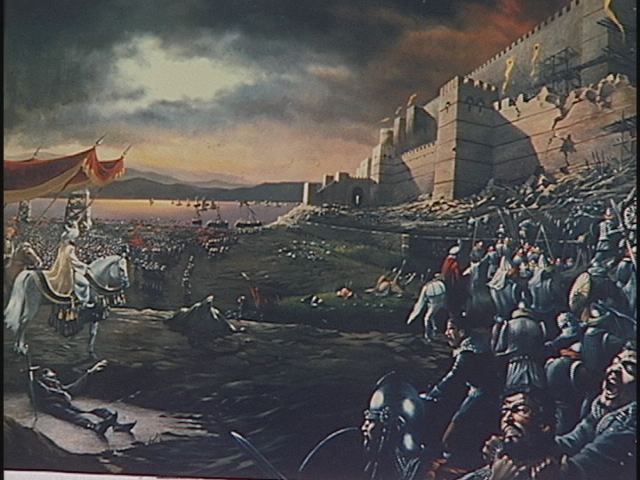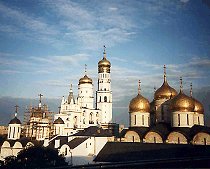The Christian East 1453-1755
WYH2003HS Spring 2003- March 11
Links
The Confession of Dositheus, patriarch of Jerusalem, also known as chapter 6 of the Acts and Decrees of the Synod of Jerusalem, 1672. This is regarded as the most important synodical statement in modern Eastern Orthodoxy, comparable to the Council of Trent in the West.
An article from the old Catholic Encyclopedia gives an overview of the Synod of Jerusalem from its pre-Vatican II perspective (the article as a whole is on Jerusalem after 1291; the Synod if 1672 is discussed about a third of the way down the page).
Someone has put onto the web a very large part of Kallistos Ware's classic The Orthodox Church, Part II, "Faith and Worship".
An introduction to Orthodoxy from the Orthodox Church in America (recognized by the Russian Orthodox Church in 1970); another REALLY HUGE introduction to Orthodoxy from the archdiocese of America of the Greek Orthodox Church
An Antiochian Orthodox priest in Manchester (it seems to be) writes on Orthodoxy and the Reformation
An Orthodox priest in Austin writes the history of the Orthodox Church after the Crusades
"Oros" or decree on western baptisms, Synod of Constantinople, 175.
The story of Vladimir's conversion to Orthodoxy in 988
Church and state in Russia, from Emory International Law Review, winter 1998
Georges Florovsky, Ways of Russian Theology
History of Imperial Russia: a big site from Dr. R. Kreuzer, St. Lawrence University, Canton, NY
Website of the Ukrainian Orthdox Church of Canada; if you follow the link to documents / repose of Job, you will find the (devotional? polemical?) story of the Venerable Job, who lived in the early 1600s and is remembered fondly for standing up against Jesuits and other Roman Catholics
A brief history of Russian Orthodox art and architecture from our period
A site with maps of Russia

Constantinople fell to the Turks in 1453, and within a few years all of the Christian East, except for Russia, was in Moslem hands. Under the Turks (in contrast to the Arabs who held sway elsewhere), Christians were allowed to practice their religion with relative freedom, and the Orthodox Church retained its structures and doctrine. However, with the end of the Roman Empire in the East, its theology of society and culture changed. The patriarch of Constantinople had jurisdiction, under the sultan, over all Christians, regardless of nationality, and synods could be held. But the freedom of the Church was very much restricted, and persecution was always a possibility.
Here are a few characteristics of Greek and Slavic Orthodoxy under the Ottoman (Turkish) Empire:
- Liturgy, which had always been important in the East, became REALLY REALLY important, since mission, evangelism, and political involvement were illegal, seminaries and publications virtually impossible, and preaching a bit delicate.
- The most important spiritual centres were the monasteries. Orthodoxy had no monastic orders, as the West did; the most important monastic reality was (and is) Mount Athos, in northern Greece, where many monasteries were built in the same general vicinity. One important form of Orthodox monastic spirituality was "hesychasm", focusing on the Jesus prayer.
- Influences from and reactions against Western Christianity became particularly important.
2. Russian Orthodoxy
 Prince
Vladimir of Kiev converted to Orthodox Christianity in 988 and his nation
followed. The head of the Russian Orthodox Church from then until 1448
was the metropolitan of Kiev, who was appointed from Constantinople, and
indeed who most of the time was a Greek.
Prince
Vladimir of Kiev converted to Orthodox Christianity in 988 and his nation
followed. The head of the Russian Orthodox Church from then until 1448
was the metropolitan of Kiev, who was appointed from Constantinople, and
indeed who most of the time was a Greek.
In the 1220s Genghis Khan swept through Russia which came under Mongol rule by 1240. The Mongol Empire protected and even privileged the Russian Church. Many monasteries were founded. Russia won independence from the Mongols in 1480. The period 1240-1480 is called the Appanage Period in Russian history. Towards the end of the period the power of Moscow was rising; an Orthodox patriarch of Moscow, independent of Constantinople, was first appointed in 1448.
The first tsar (caesar) was Ivan IV "The Terrible", who ruled with great ruthlessness 1547-1584, and left the country in shambles. In church affairs, by the Synod of Brest, 1596, Little Russia entered an ecclesiastical union with Roman Catholicism. The "time of troubles" (1598-1613) was characterized by famines, rival claimants to the throne, and wars. Then Michael Romanov was elected tsar (the Romanov dynasty ruled until the Russian Revolution of 1917.) The importance of Russia in the world of Christian Orthodoxy is on the rise; Moscow is seen by many as "the third Rome".
In the mid-seventeenth century Patriarch Nikon worked hard to reform the Church, supported by Alexis; a council of 1654 supported his reforms. He also brought Kiev and most of its clergy out of its union with Rome and back under the authority of Moscow. Unfortunately he provoked Tsar Alexis with his theology of the authority of the Church over the state and he was deposed in 1666, and confined to a monastery. The mainstream of Russian Orthodoxy maintained his reforms; the opposition, which came to be called the "Old Believers", began a schism which lasted for two centuries. Persecution of the Old Believers began formally in 1684.
Relations with the Christian West were often strained but there were many connections. The Kremlin, pictured above right, was re-designed by Italian architects (1475 and 1510). At the end of the seventeenth century, Tsar Peter the Great (Fedor) took a particular interest in things Western.